Running is more than just movement—it’s freedom, speed, and power. For amputees, modern prosthetic technology has made it possible to experience running just as efficiently as anyone else. The most advanced solution for this is the high-performance running blade, a specialized prosthetic designed to mimic the mechanics of a natural foot while delivering speed, stability, and energy return.
Running blades have transformed the way amputees participate in sports, from casual joggers to elite sprinters competing on global stages. But what makes these blades so effective? How do they store and release energy, and why are they shaped the way they are? The answer lies in the perfect combination of biomechanics, material science, and engineering precision.
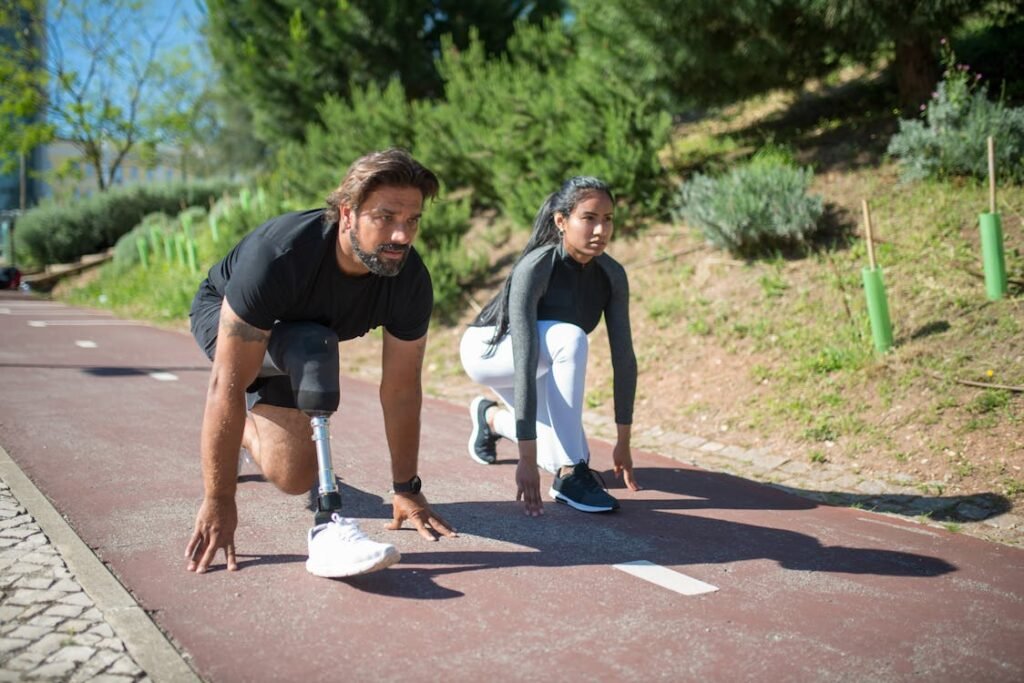
How Running Blades Work: The Science of Energy Return
Running with a prosthetic limb is very different from running with a natural leg. A biological foot absorbs impact and pushes off the ground with muscle-driven force, while a prosthetic blade relies entirely on its material and design to store and release energy efficiently.
The core principle behind running blades is energy return. When a runner lands on the blade, it bends slightly, absorbing energy from the impact.
As the runner pushes forward, the blade springs back to its original shape, releasing that stored energy and propelling the user forward. This is what gives running blades their signature “bounce”, helping athletes maintain speed and reduce effort.
The effectiveness of a running blade depends on several factors, including blade stiffness, curvature, and alignment. A well-designed blade provides maximum propulsion with minimal energy loss, allowing runners to move smoothly and efficiently.
Unlike a standard prosthetic foot, which is designed for walking and stability, running blades prioritize motion, flexibility, and power.
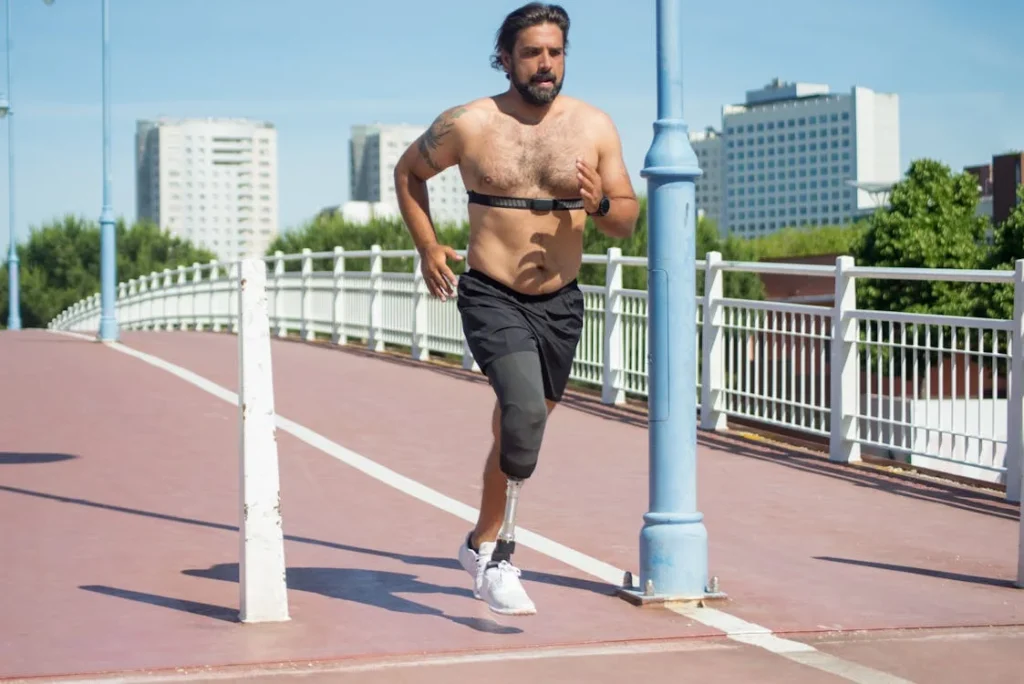
The Biomechanics of Running with a Blade
Running with a prosthetic blade requires a different movement pattern than running with biological legs. Since a natural foot has muscles and tendons that generate force, the body relies on those structures to push off the ground and maintain balance.
A running blade, however, depends entirely on its curvature and material elasticity to store and return energy.
How Blade Mechanics Affect Stride and Posture
When a runner using a blade makes contact with the ground, the blade bends slightly under pressure. This bending action mimics how an Achilles tendon stretches when a person takes a step.
The more force that is applied, the more the blade compresses, and the more energy it can return. However, this also means that runners need to adjust their stride and posture to maximize efficiency.
Unlike a traditional foot that rolls from heel to toe, a running blade typically has a single point of contact with the ground. This means runners must learn to land in a way that optimizes stability and energy transfer.
Many blade users adopt a slightly shorter, quicker stride compared to runners with biological legs. This helps maintain balance and ensures the blade’s spring-like motion is fully utilized.
Because running blades don’t have an ankle joint, they require more core and hip engagement to control movement. The runner must use their upper body and residual limb to maintain balance and avoid unnecessary strain.
Over time, experienced blade users develop a natural rhythm that allows them to run smoothly and efficiently.
The Role of Blade Stiffness and Length
Two critical factors determine how well a running blade performs: stiffness and length. Both must be carefully chosen based on the runner’s weight, running style, and level of activity.
Blade stiffness affects how much energy is stored and released with each step. A stiffer blade offers more explosive energy return, making it ideal for sprinters who need maximum propulsion.
However, if the blade is too stiff for a runner’s weight and strength, it can feel rigid and inefficient. A more flexible blade, on the other hand, provides a smoother ride and is often preferred by long-distance runners who need sustained energy return over time.
Blade length also plays a major role in performance. A longer blade provides greater stride length and energy return, but it requires more control and balance.
Competitive athletes often work with prosthetists to fine-tune blade height, ensuring that it matches their body proportions and running mechanics.

Materials and Design: What Makes a Running Blade So Efficient?
The incredible performance of running blades comes down to the science of materials and precision engineering.
Unlike standard prosthetic limbs, which are built for stability and everyday use, running blades are designed to be lightweight, flexible, and highly responsive.
The choice of materials and the unique curved design work together to create maximum energy return with minimal weight.
Why Carbon Fiber is the Gold Standard
Most high-performance running blades are made from carbon fiber, a material known for being light, strong, and highly elastic. Carbon fiber is perfect for running prosthetics because it allows for controlled bending while maintaining durability and strength.
When a runner lands on a blade, the carbon fiber flexes, storing energy in its fibers. As the runner pushes forward, the blade quickly snaps back to its original shape, releasing that stored energy and propelling the user forward.
This is what gives runners using blades their spring-like bounce, allowing them to maintain speed with less effort.
Another reason carbon fiber is the preferred material is its weight-to-strength ratio. A running blade needs to be strong enough to handle repeated impact but light enough to allow for effortless movement.
Carbon fiber achieves this balance better than metals or plastics, making it ideal for high-speed, high-performance sports.
The Signature Curved Shape: More Than Just Aesthetic
The curved design of a running blade isn’t just for looks—it plays a crucial role in how the blade functions. The shape allows the blade to store and release energy efficiently, mimicking the natural movement of a biological foot.
The curve also affects how the runner balances and controls movement. Since the blade doesn’t have an ankle joint, the natural spring-like motion helps compensate for the lack of a foot’s rolling movement.
This curved structure reduces impact forces, protecting the runner’s residual limb from excessive stress.
Different blade designs exist for different types of running. Sprinters often use shorter, stiffer blades with an aggressive curve to generate maximum power in short bursts.
Long-distance runners, on the other hand, prefer longer, slightly more flexible blades that provide smooth, sustained energy return over long distances.
Customization: Why No Two Running Blades Are the Same
Every runner has different needs, which is why running blades are often customized for each individual. Factors like weight, height, running style, and amputation level all influence how a blade should be designed and adjusted.
A prosthetist carefully selects the blade stiffness, length, and suspension system to match the runner’s unique biomechanics. Even small adjustments in blade positioning or angle can make a huge difference in speed, comfort, and efficiency.
At Robobionics, we specialize in customized running prosthetics designed for both beginner and professional athletes. Our advanced materials and precision engineering ensure that every blade delivers the best possible performance.
If you’re looking for a prosthetic that matches your running goals, book a consultation with us today to find the perfect fit.
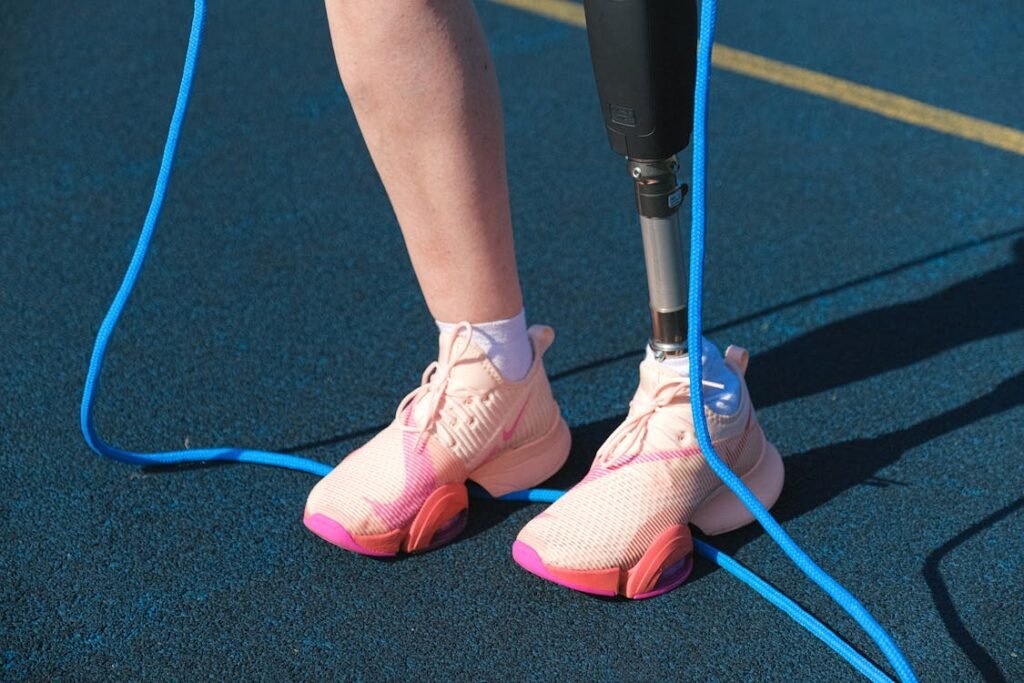
How Running Blades Compare to Biological Legs
Running with a blade is a completely different experience from running with biological legs. While modern prosthetic technology has made it possible for amputees to compete at elite levels, the mechanics of movement, energy efficiency, and stride pattern are still distinct.
Understanding these differences helps runners adapt to their blades and maximize their performance.
Differences in Energy Efficiency
One of the biggest differences between a running blade and a biological leg is how energy is stored and released. A natural foot and ankle use muscles, tendons, and joints to generate force and push off the ground.
The Achilles tendon, in particular, plays a major role in absorbing impact and returning energy, helping runners move forward with minimal effort.
A running blade, on the other hand, relies entirely on its carbon fiber structure to store and return energy. While blades are designed to mimic the spring-like function of tendons, they lack the adaptability and fine motor control of a real foot.
This means that blade runners need to be strategic about how they distribute their weight and time their push-offs to get the best energy return.
Because of this difference, amputee runners use more energy than able-bodied runners to maintain the same speed. However, well-fitted and properly aligned blades can help close this energy gap, allowing athletes to compete at high levels with less fatigue.
Stride Length and Step Timing
Another key difference between running blades and biological legs is stride length and step timing. In able-bodied runners, each footstrike follows a rolling motion from the heel to the toe, allowing for a natural transfer of momentum.
This movement helps with stability and balance, especially at high speeds.
For runners using blades, the footstrike is more direct. Since there is no heel, the blade usually makes contact with the ground at a single point, often toward the midfoot or forefoot area.
This means that amputee runners must adjust their step timing and ground contact pattern to maintain efficiency.
Most blade runners adopt a shorter, quicker stride compared to traditional runners. This helps improve stability and control, ensuring that the blade flexes and rebounds in a way that maximizes propulsion.
Sprinters, in particular, must focus on explosive push-offs to make up for the lack of an active ankle joint.
Balance and Upper Body Involvement
Since running blades don’t have an active ankle to make small stability adjustments, blade runners rely more on their core, hips, and upper body to maintain balance. The lack of a heel also means that stopping or changing direction quickly requires more control.
Many amputee runners engage in core-strengthening exercises to improve stability and posture. A strong core allows for better energy transfer from the prosthetic limb to the rest of the body, making running feel smoother and more controlled.
At Robobionics, we work closely with athletes to fine-tune blade alignment and optimize running mechanics. Whether you’re a beginner learning to run or an advanced athlete looking to refine your technique, our team ensures that your prosthetic supports your goals.
If you’re ready to take your running to the next level, schedule a consultation with us today.

The Role of Technology in Advancing Running Blades
The science behind running blades has come a long way, and with ongoing advancements in prosthetic technology, amputee athletes are achieving greater speed, efficiency, and comfort than ever before.
Modern innovations focus on making running blades lighter, stronger, and more adaptive to movement, allowing runners to compete at elite levels while reducing physical strain.
Advanced Carbon Fiber Engineering
While carbon fiber has been the preferred material for running blades for years, today’s technology allows for even more precise layering and molding.
Engineers can now fine-tune the flexibility and stiffness of different sections of the blade, optimizing energy return without sacrificing stability.
Some modern blades incorporate multi-directional fiber weaves, which improve durability while maintaining responsiveness. This means that athletes can apply greater force without the blade becoming too rigid or uncomfortable.
As a result, new-generation blades offer a smoother, more controlled bounce, making running more natural and efficient.
Customized Blade Profiles for Different Sports
Not all running blades are designed the same way. Engineers are now creating sport-specific blade designs that cater to different running styles and activities.
Sprinters, for example, require blades that maximize propulsion in short bursts, meaning a stiffer, more aggressively curved design works best.
Marathon runners, on the other hand, need a balance between flexibility and endurance, so their blades tend to be longer and slightly more forgiving in their energy return.
For athletes who compete in multiple sports, some blades are now being designed with interchangeable footplates and adjustable stiffness settings, allowing for greater versatility.
This means that a runner can tweak their prosthetic to match different track surfaces, weather conditions, or racing styles.
Smart Prosthetics and Sensor Integration
One of the most exciting developments in prosthetic technology is the integration of smart sensors and adaptive response systems.
While traditional running blades rely solely on passive energy return, new models are exploring the potential for real-time data tracking and automated stiffness adjustments.
Some experimental blades come with built-in pressure sensors, which monitor impact force and stride efficiency.
This data can be used to fine-tune the blade’s alignment and improve running posture. In the future, we may see prosthetics that can actively adapt to different running speeds and terrain, offering a level of flexibility closer to a biological foot.
Reducing Impact on the Residual Limb
One challenge with running blades is the stress they place on the residual limb. Unlike a biological leg, which has muscles and joints to absorb shock, the force from running is often concentrated at the point where the blade connects to the limb.
To address this, researchers are developing more advanced socket designs and shock-absorbing suspension systems. These improvements help distribute pressure more evenly, reducing the risk of skin irritation, discomfort, and long-term joint strain.
Some new designs also feature dynamic pylons, which act as a buffer between the socket and the blade, allowing for better shock absorption and smoother transitions between steps.
At Robobionics, we stay at the forefront of prosthetic innovation, ensuring that our running blades incorporate the latest advancements in material science and biomechanics.
If you’re looking for a high-performance running blade tailored to your needs, contact us today for a personalized consultation.
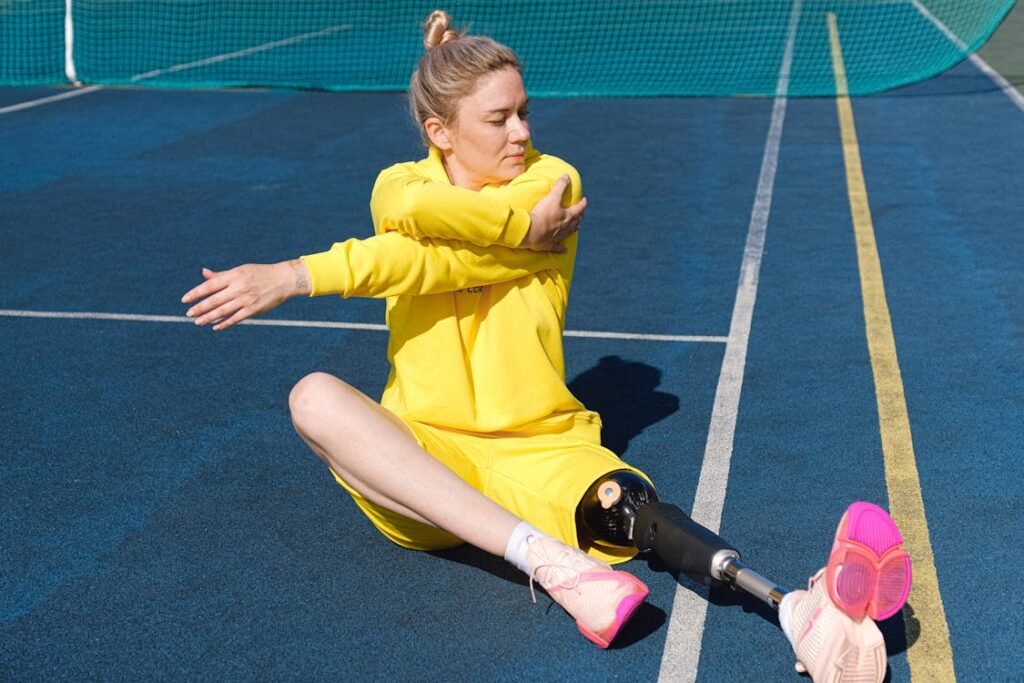
Psychological and Emotional Impact of Running with a Blade
Running is not just about physical ability—it’s also a mental and emotional journey. For many amputees, using a running blade is more than just a way to stay active; it represents freedom, confidence, and the ability to overcome obstacles.
While the technology behind running blades is impressive, the psychological adaptation is just as important.
Overcoming Fear and Building Confidence
One of the biggest challenges new blade runners face is overcoming the fear of falling or losing control. Unlike walking prosthetics, which are designed for balance and stability, running blades require users to trust in the spring-like mechanics of the blade.
The sensation of bouncing forward rather than stepping can feel unnatural at first, making it difficult for beginners to find their rhythm.
Building confidence starts with small victories. Many new runners begin by jogging on soft surfaces like grass or a running track to reduce impact in case of a fall.
Working with a coach or physical therapist can also help ease the transition, as professional guidance ensures proper form and technique. Over time, as the body adapts and movement feels more natural, the fear of instability is replaced by a sense of empowerment.
The Psychological Boost of Movement
For many amputees, returning to sports after limb loss can feel like reclaiming a lost part of themselves. The ability to run again provides a powerful mental boost, improving self-esteem and overall well-being.
Studies have shown that physical activity helps reduce anxiety, combat depression, and increase overall happiness, making running an essential part of both physical and emotional rehabilitation.
Running with a blade also fosters a deep sense of resilience and determination. Unlike able-bodied runners, blade users must go through an intense adaptation process, mastering new movement patterns and overcoming physical challenges unique to prosthetic use.
Each milestone—whether it’s running a short distance without stopping or completing a full race—becomes a symbol of strength and perseverance.
Breaking Barriers in Competitive Sports
The presence of amputee runners in elite competitions has also reshaped public perceptions of disability in sports.
Athletes like Oscar Pistorius, Blake Leeper, and Markus Rehm have demonstrated that amputee runners can compete at the highest levels, often challenging traditional ideas about athletic performance.
However, controversies around running blades in professional sports have sparked important discussions.
Some argue that advanced prosthetic technology gives amputee athletes an unfair advantage, while others highlight that blade runners actually expend more energy than able-bodied runners to maintain similar speeds.
Despite these debates, the growing presence of amputee athletes in international sports has helped push forward greater acceptance and inclusion.
Running as a Tool for Social Connection
Running with a prosthetic isn’t just an individual journey—it’s also an opportunity to connect with a supportive community.
Many amputees find motivation through adaptive sports programs, running clubs, and online communities, where they can share experiences and encourage one another.
Participating in races, whether competitively or recreationally, allows amputees to challenge stereotypes and inspire others.
Events like the Paralympic Games, Invictus Games, and local disability sports initiatives provide platforms for athletes with limb loss to showcase their abilities, proving that prosthetics are not limitations but tools for achievement.
At Robobionics, we believe that prosthetic technology should empower users not just physically, but mentally and emotionally as well. If you’re looking to take the next step in your running journey, reach out to us today for expert guidance and support.
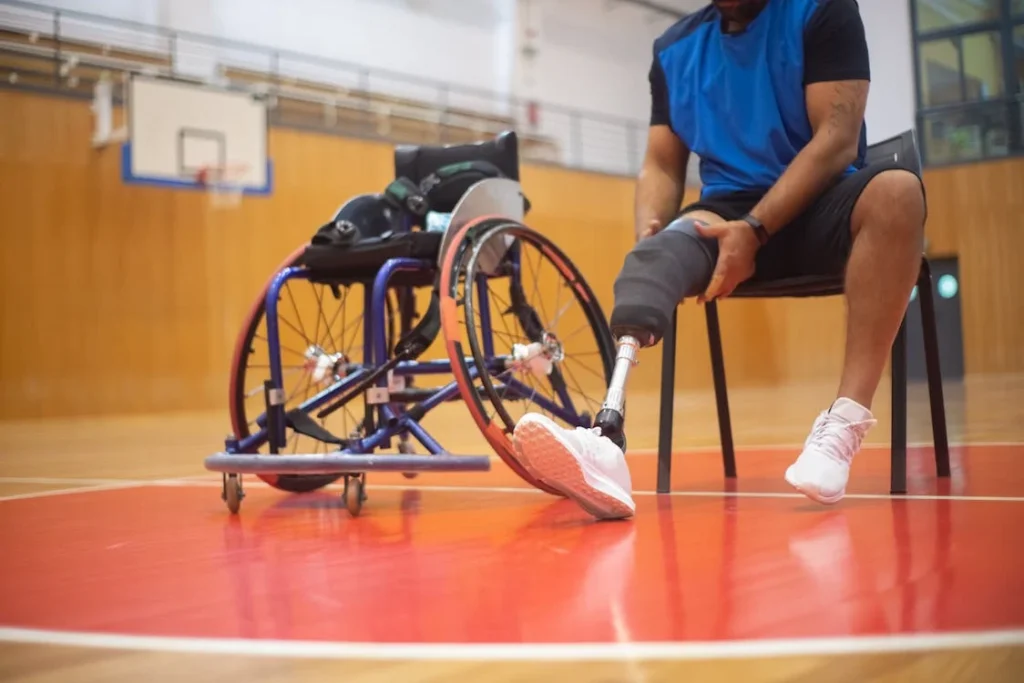
The Role of Rehabilitation and Training in Maximizing Running Blade Performance
Getting a high-performance running blade is only the first step in becoming an efficient and confident runner. Without proper rehabilitation and training, even the most advanced prosthetic won’t deliver the best results.
The body needs time to adjust, develop strength, and master new movement patterns. A structured approach to rehabilitation ensures that runners can make the most of their prosthetic while reducing the risk of injuries.
Rehabilitation After Amputation: Laying the Foundation
For new amputees, rehabilitation starts long before they receive their running blade. The body needs to recover from surgery, adapt to weight-bearing on the residual limb, and regain balance and coordination.
Physical therapists focus on strengthening the hip, core, and remaining leg muscles, which play a crucial role in maintaining stability when using a prosthetic.
One of the key areas of focus in early rehabilitation is proprioception, or the body’s ability to sense its position in space.
Because a running blade doesn’t provide direct sensory feedback like a natural foot, amputees must rely on their core strength, vision, and residual limb sensitivity to stay balanced.
Exercises like single-leg stands, controlled stepping drills, and balance board training help improve this awareness before transitioning to high-impact movement.
Transitioning to Running: Learning the Basics
Once a runner receives their blade, the next step is adapting to the new mechanics of movement. The first few sessions often focus on simply standing and walking with the blade, allowing the body to adjust to the spring-like motion.
Unlike regular prosthetics, which provide a stable base, running blades are curved and flexible, requiring users to find a new sense of balance.
Runners are encouraged to start with light jogging on soft, even surfaces, such as a running track or grass field.
Since running blades don’t have a traditional heel, the focus is on forefoot striking, where the blade makes contact with the ground near the midfoot or toe area. This is a significant shift from walking mechanics, which rely on a heel-to-toe motion.
Many athletes find that shorter, quicker strides help them maintain better control. Running with a blade isn’t just about pushing off—it’s about properly timing the energy return so that each step feels smooth and natural.
Coaches and prosthetists work closely with runners to fine-tune stride length, knee lift, and arm movement, ensuring that all elements of the gait cycle work together efficiently.
Strength and Conditioning for Blade Runners
Since running with a blade places different demands on the body compared to natural running, strength training is essential to prevent injuries and improve endurance.
A well-balanced training program includes core exercises, hip stability drills, and explosive power movements to help the body adapt to the unique biomechanics of using a blade.
Core strength is particularly important because it helps maintain posture and control when running. Exercises like planks, rotational drills, and resistance band training can improve overall stability.
Hip and glute activation drills, such as step-ups, side lunges, and single-leg deadlifts, strengthen the muscles that control leg movement, reducing strain on the residual limb.
For sprinters, plyometric exercises like box jumps, bounding drills, and sled pushes help train the muscles to generate quick bursts of power, complementing the spring-like motion of the running blade.
Long-distance runners, on the other hand, focus on endurance-building workouts, such as controlled resistance training and sustained running intervals, to improve stamina.
Fine-Tuning Performance with Gait Analysis
Even experienced blade runners continue to make small adjustments to improve their efficiency. Gait analysis technology allows runners to track how they distribute force, identify any imbalances, and make precise modifications to their running form.
High-speed cameras, force plates, and motion sensors provide real-time data on stride symmetry, impact distribution, and energy efficiency.
Prosthetists use this information to adjust blade alignment, socket fit, and stiffness settings, ensuring that each athlete gets the best possible performance from their prosthetic.
At Robobionics, we emphasize comprehensive training and rehabilitation to help runners adapt smoothly to their prosthetic blades.
Whether you’re just starting out or looking to refine your technique, our experts provide personalized support to maximize your performance. Book a consultation today and take your running to the next level!
Conclusion
High-performance running blades are more than just prosthetic limbs—they are engineered tools that allow amputees to run with power, speed, and efficiency. By combining cutting-edge materials, biomechanics, and expert craftsmanship, these blades provide incredible energy return, enabling athletes to push their limits.
However, success with a running blade isn’t just about technology—it’s about training, adaptation, and mental resilience. From learning how to balance and stride efficiently to building strength and confidence, the journey of a blade runner is one of perseverance and growth. With the right prosthetic fit, rehabilitation, and expert guidance, any amputee can develop the skills needed to run comfortably and competitively.
At Robobionics, we are committed to helping athletes find the perfect prosthetic solution, offering customized running blades, expert fittings, and performance optimization. Whether you’re just starting or aiming to compete at the highest level, we’re here to support your journey.
If you’re ready to take the next step in your running experience, book a consultation with Robobionics today and discover the difference a high-performance running blade can make!



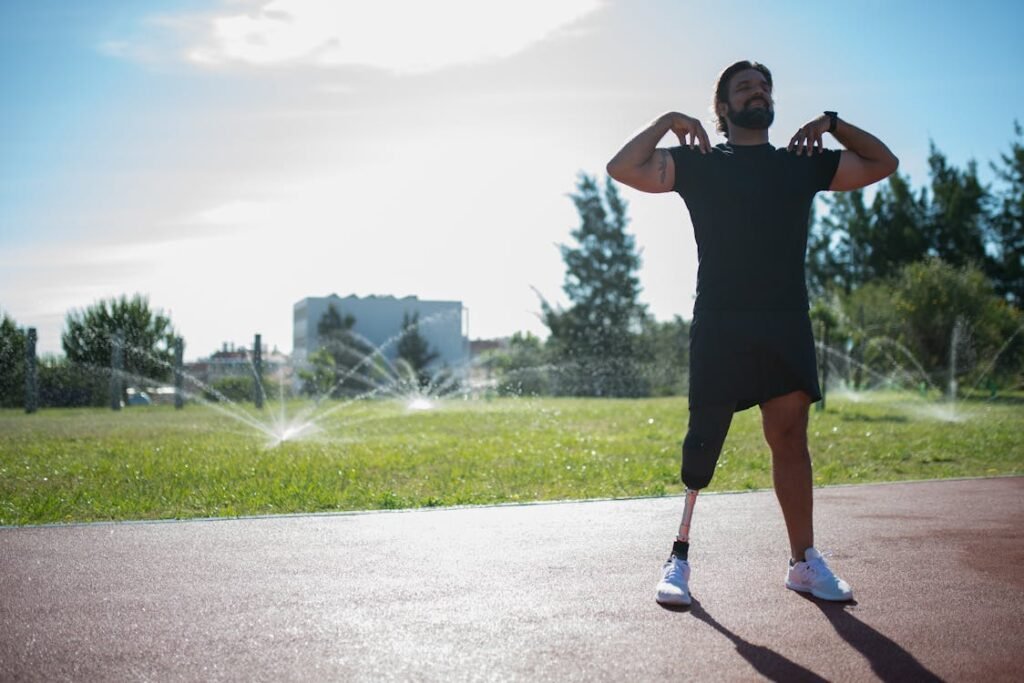
Fascinating breakdown of how prosthetic blade technology empowers amputee runners—truly inspiring!Book your exclusive flight today! I’d be thrilled to connect and discuss .📞 Call Us: +91 988 609 9678 📧 Email: customerservice@flyblade.in 🌐 Visit Us: http://www.privatecharters.in